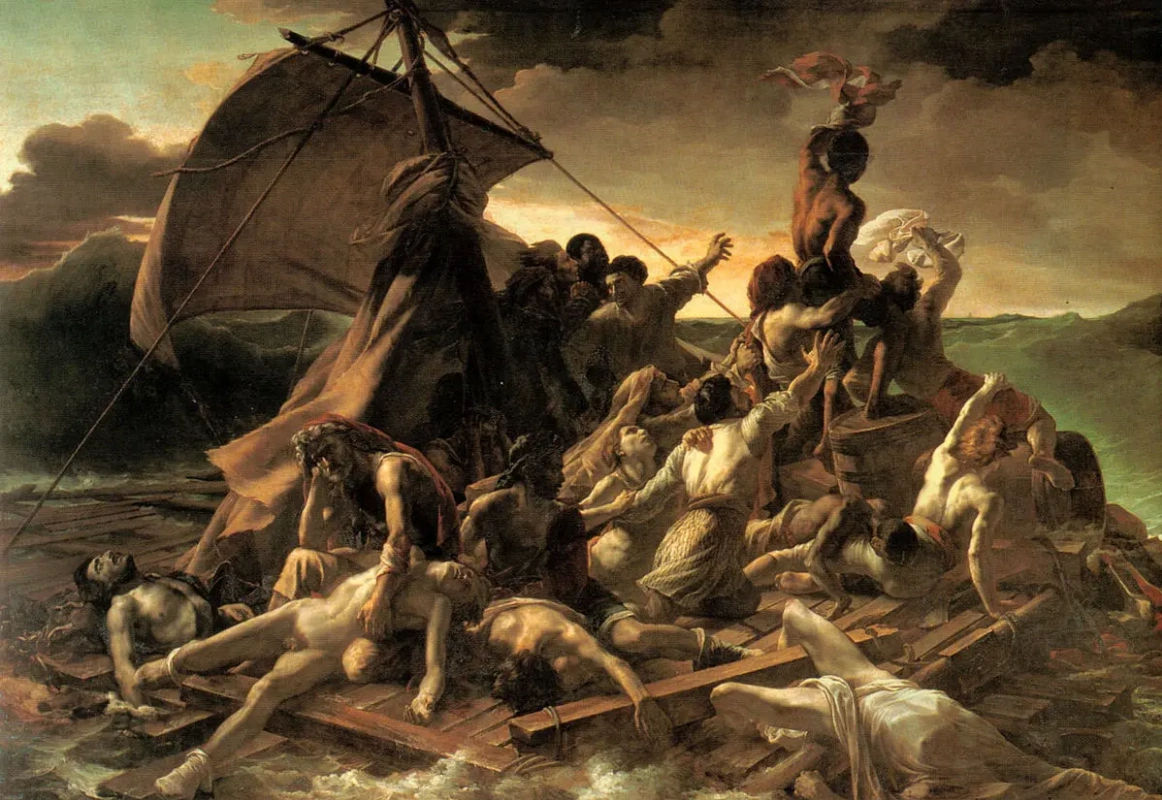log in
Enter site
Login to use Arthive functionality to the maximum
Floß "Medusa"
Théodore Géricault • Malerei, 1819, 491×716 cm


















Bildbeschreibung «Floß "Medusa"»
Im Mittelpunkt der Handlung des Bildes steht ein echter Vorfall am 2. Juli 1816 vor der Küste Senegals. Auf den Untiefen von Argen stürzte die Fregatte Medusa in 40 Meilen von der afrikanischen Küste ab. In Anbetracht dessen, dass das Schiff brechen konnte, gerieten die Passagiere und die Crew in Panik, und der Kapitän beschloss, das Schiff sofort zu verlassen. Siebzehn Leute blieben auf der Fregatte 147 Mann wechselte zu einem Floß. Auf einem überladenen Floß gab es wenig zu essen, keine Kontrollen und keine Navigation.
Bei den Wetterbedingungen vor dem Sturm erkannte die Crew auf den Booten bald, dass das Ziehen eines schweren Floßes fast unmöglich war. Aus Angst, dass die Passagiere auf dem Floß in Panik in Boote geraten könnten, durchtrennen die Leute in den Booten die Abschleppseile und steuerten auf das Ufer zu. Alle Überlebenden in Booten, einschließlich des Kapitäns und des Gouverneurs, erreichten die Küste getrennt.
Bei den Wetterbedingungen vor dem Sturm erkannte die Crew auf den Booten bald, dass das Ziehen eines schweren Floßes fast unmöglich war. Aus Angst, dass die Passagiere auf dem Floß in Panik in Boote geraten könnten, durchtrennen die Leute in den Booten die Abschleppseile und steuerten auf das Ufer zu. Alle Überlebenden in Booten, einschließlich des Kapitäns und des Gouverneurs, erreichten die Küste getrennt.
Position auf einem Floß, dem Schicksal ausgeliefert, wurde zu einer Katastrophe. Die Überlebenden waren in gegnerische Gruppen unterteilt - Offiziere und Passagiere einerseits und Matrosen und Soldaten andererseits. In der ersten Nacht der Drift wurden 20 Menschen getötet oder Selbstmord begangen. Während des Sturms starben Dutzende Menschen im Kampf um den sichersten Ort im Zentrum in der Nähe des Masts, wo die knappen Vorräte an Nahrung und Wasser aufbewahrt wurden oder von der Welle über Bord gespült wurden. Am vierten Tag nur überlebt 67 Ein Mann, viele von ihnen gequält vom Hunger, begannen, die Leichen der Toten zu essen. Am achten Tag 15. Die stärksten Überlebenden warfen die Schwachen und Verwundeten über Bord und dann alle Waffen, um sich nicht zu töten. Die Details des Schwimmens schockierten die moderne öffentliche Meinung. Der Kapitän der Fregatte Hugo Duroy de Shomarey, ein ehemaliger Emigrant, der für den Großteil der Floßpassagiere verantwortlich war, wurde unter dem Schutz ernannt (er wurde später verurteilt und erhielt eine Bewährungsstrafe, die jedoch nicht der Öffentlichkeit angezeigt wurde). Die Opposition machte die Regierung für das Geschehene verantwortlich. Das Seefahrtsministerium versuchte, den Skandal zu vertuschen, und versuchte zu verhindern, dass Informationen über die Katastrophe in der Presse auftauchten.
Im Herbst 1817 wurde das Buch Der Tod der Medusa-Fregatte veröffentlicht. Augenzeugen der Veranstaltung, Alexander Correar und der Arzt Henri Savigny, schilderten in ihr ein dreizehn Tage langes Floß. Das Buch fiel in die Hände von Gericault, der in der Geschichte sah, wonach er seit vielen Jahren gesucht hatte - die Handlung seiner großen Leinwand. Das Drama "Medusa", anders als die meisten Zeitgenossen, einschließlich seiner engen Freunde, empfand der Künstler als universelle, zeitlose Geschichte.


